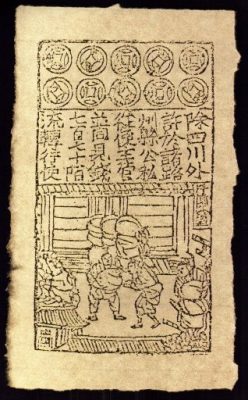Paper money was first invented in China and popularized during the Song Dynasty (960-1276 AD). During this time, both domestic and international trade flourished. Historians even cite this period as a “commercial revolution” in China. The previous standard of only using metal coins for currency was no longer feasible. Merchants needed a more convenient way to carry large sums of money, so they started carrying paper notes. Paper money was easier to transport than metal coins and allowed for larger transactions. However, just because paper money was introduced did not mean coins were no longer used. In fact, paper money and coins were both used as currency during the Song Dynasty.
Origin of Paper Money in China
The Song Dynasty wasn’t the first to use paper money, as the concept originated in China during the Tang Dynasty (618-907). Paper notes were used to replace coins, which were often difficult to transport because of their weight. Carrying strings of coins on your person also makes you more vulnerable to theft. To counter these issues, merchants left strings of coins with trusted agents in deposit shops, who would then issue a note certifying the deposit. The note could then be used to buy goods from other merchants in place of coins. They could also withdraw these coins by presenting the note to the same shop or other accredited shops. This type of note was called hequan.
When the government found that this system was working, they undertook measures to standardize it and asked merchants to deposit their strings of coins in the government treasury. Once they do, they would be given an official note known as a feipiao (or “flying cash”) because it could be easily transported and used to buy things in different places. However, this system had its limitations, as the notes functioned more as promissory notes rather than actual paper currency. It wasn’t until the Song Dynasty that paper money became widely used.
Use of Paper Money in the Song Dynasty
Merchants in the Song experienced the same issues as those in the Tang Dynasty, in that large amounts of coins were too heavy to transport. In the province of Sichuan, merchants came up with their own solution in the form of jiaozi, which was basically pieces of paper that represented strings of coins. They would deposit these pieces of paper with local shops, which would then give them notes in return. These notes could be used to buy goods from other merchants. Initially, there were no standard designs for these notes, so after five years of jiaozi being in circulation, 16 of the largest merchant companies in the province founded a paper note bank (Jiaozi hu) to standardize the design. Jiaozi became so popular that the local government recognized it as a form of currency. Bankruptcy and counterfeiting became issues, so the government took over the production of paper money in 1023 and began circulating it throughout the empire. A year later, standard denominations were established.
However, inflation became a problem. In 1105, during the reign of Emperor Huizong, the jiaozi was replaced with a new paper currency known as the qianyin. Unfortunately, this did not fix the inflation problem because the government did not have enough coins to back up the currency. The government eventually set an expiration date of 2 years for each note, which was raised to 3 years in 1199. This meant that notes had to be either redeemed before they expired or replaced by newer notes. The government also officially restricted the amount of paper money that could be in circulation to 1,255,340 mín.
Paper Money After the Song Dynasty
In 1455, during the Ming Dynasty (1368-1644), the government completely did away with paper currency. Despite being the first to use paper money, China was one of the last to rejoin the fiat standard. It wasn’t until the 20th century that paper currency made a comeback in China.
